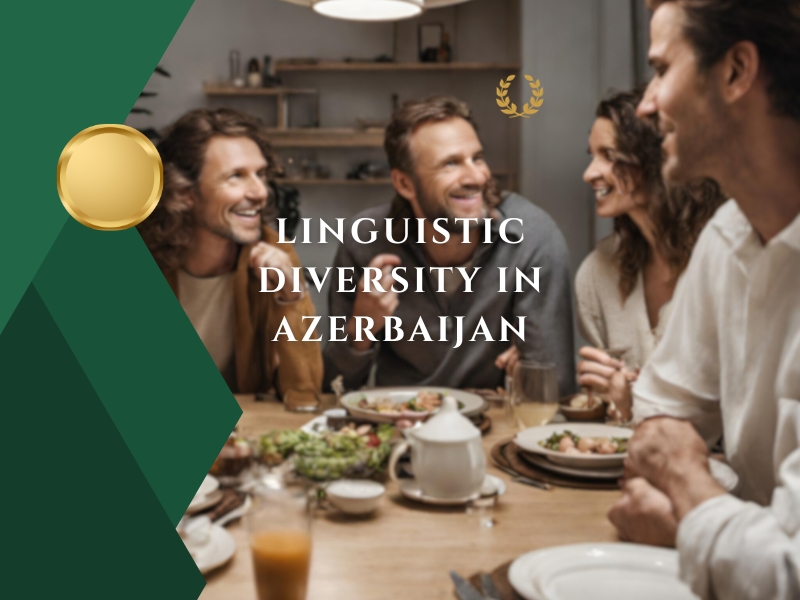Nestled in the South Caucasus, the Republic of Azerbaijan stands as a cultural treasure trove, where languages form the vibrant threads of its intricate tapestry. Beyond its stunning landscapes, Azerbaijan’s linguistic diversity is an emblem of its extraordinary heritage. This exploration is an odyssey through the linguistic kaleidoscope of Azerbaijan, revealing not just the languages’ unique attributes but also their profound cultural importance. It’s an opportunity to understand the soul of a nation through the diverse languages that echo its history, ethnicity, and enduring spirit. Join us as we unravel the captivating linguistic landscape of Azerbaijan, where each language tells a story, and together, they create a masterpiece.
Language and Cultural Identity
Languages in Azerbaijan are the very essence of cultural identity, serving as conduits for preserving the rich heritage of its multifaceted communities. Each language encapsulates a unique narrative, reflecting the customs, traditions, and values cherished by the people who speak it. These languages are the threads that weave together the intricate fabric of Azerbaijani society, connecting past generations to the present and ensuring the transmission of cultural treasures to the future. They are not mere tools of communication; they are living repositories of history and tradition, embodying the heart and soul of the nation’s diverse cultural mosaic. In this tapestry of linguistic diversity, the people of Azerbaijan find their roots, their stories, and their shared sense of belonging.
The Significance of Linguistic Diversity
Linguistic diversity in Azerbaijan is a vibrant testament to the nation’s pluralistic spirit. It extends far beyond a mere collection of words; it’s a celebration of the unique identities and histories of the various communities that thrive within the country. This diversity not only underscores the richness of Azerbaijani culture but also acts as a bridge, fostering cross-cultural understanding and empathy. It’s a testament to the idea that unity can be found in diversity, as each language, with its distinct vocabulary and expressions, contributes to the colourful tapestry of the nation’s cultural heritage. Through linguistic diversity, Azerbaijan showcases its commitment to inclusivity and respect for the traditions of all its communities, ensuring that the nation’s collective identity remains strong and resilient in the face of a changing world.
Azerbaijani: The Unifying Tongue
Azerbaijani, the official language of Azerbaijan, stands as a unifying force in this culturally diverse nation. With the majority of the population speaking Azerbaijani, it serves as a common thread that binds together people from various ethnic backgrounds and regions. This linguistic unity enables seamless communication, fostering a sense of national identity and solidarity. Azerbaijani is not just a means of conversation; it’s a reflection of the country’s collective heritage. Its rich vocabulary, influenced by both Turkic and Persian roots, carries the echoes of centuries of history, literature, and culture. In essence, Azerbaijani is more than just words; it’s the connective tissue that weaves together the intricate tapestry of Azerbaijan’s multicultural society, emphasizing the nation’s commitment to unity amid diversity.
Lezgian: The Melodious Language
Lezgian, a language spoken primarily in the northern regions of Azerbaijan, is celebrated for its unique and melodious characteristics. This language is not just a means of communication but a reflection of the rich cultural heritage of the Lezgian people. Known for its intricate grammar and poetic qualities, Lezgian holds a special place in the hearts of its speakers. Efforts to preserve this linguistic treasure are ongoing, as it symbolizes a vital part of Azerbaijan’s diverse linguistic landscape. Through Lezgian, the cultural identity of the Lezgian community is passed down from one generation to the next, contributing to the nation’s linguistic mosaic and reinforcing the importance of preserving linguistic diversity in Azerbaijan.
Talysh: The Poetic Tongue
Talysh, a language spoken predominantly in the southern regions of Azerbaijan, is renowned for its rich poetic traditions. This language serves as a living repository of culture and history, as its speakers use it to narrate and celebrate their heritage. Talysh poetry, with its lyrical beauty, has played a pivotal role in preserving the unique identity of the Talysh people. Through their verses, they pass down stories of their ancestors, traditions, and the profound connection they share with the land. Talysh is not merely a mode of communication; it’s a source of pride and a testament to the enduring spirit of a community that values its linguistic and cultural legacy. In a nation marked by linguistic diversity, Talysh adds a vibrant thread to the tapestry of Azerbaijan’s cultural heritage, emphasizing the importance of preserving and celebrating the nation’s varied languages and traditions.
Udin: Ancient Christian Heritage
Udin, an ancient language spoken in Azerbaijan, is deeply intertwined with the nation’s historical religious diversity. With its roots in Christianity, it serves as a living testament to Azerbaijan’s long-standing tradition of religious tolerance. The Udin people, who primarily reside in the village of Nij in northern Azerbaijan, have preserved their unique Christian heritage for centuries. Their language, closely tied to their faith, is a testament to the harmonious coexistence of different religious communities in Azerbaijan. Udin is not just a linguistic relic; it’s a reminder of the rich tapestry of religious and cultural traditions that have thrived within the country’s borders. In a world where religious diversity is often a source of division, Udin represents a unique example of how different faiths and languages can peacefully coexist, contributing to the cultural mosaic that defines Azerbaijan.
Tat: A Linguistic Gem
Tat, a linguistic gem nestled in northern Azerbaijan, is the language of the Tat people. This unique language adds a distinctive thread to the rich tapestry of linguistic diversity in the region. The Tat language has deep historical and cultural roots, reflecting the heritage of its speakers who have resided in these lands for generations. Despite the challenges posed by the modern world, the Tat people and their language continue to thrive, a testament to their unwavering commitment to preserving their linguistic heritage. Tat serves as a living reminder of Azerbaijan’s dedication to honouring and nurturing its diverse cultural and linguistic traditions, showcasing the resilience and cultural richness of the Tat community within the nation’s broader mosaic of languages and cultures.
Udi: A Language Rediscovered
Udi, an endangered language, is experiencing a remarkable resurgence in Azerbaijan, thanks to the dedicated efforts of linguists, scholars, and passionate community members. Once on the brink of fading into obscurity, Udi is now being revitalized and celebrated as a vital part of Azerbaijan’s linguistic heritage. This revival reflects the nation’s commitment to preserving its diverse cultural and linguistic traditions, ensuring that languages like Udi continue to thrive. The resurgence of Udi is a testament to the enduring spirit of the Udi community and their determination to pass on their unique linguistic and cultural legacy to future generations. It adds yet another layer of linguistic richness to Azerbaijan’s vibrant tapestry of languages, highlighting the country’s unwavering dedication to cultural diversity and heritage preservation.
Kryts: A Unique Dialect
The Kryts community, nestled in the northern regions of Azerbaijan, possesses a unique linguistic heritage known as Kryts. This North Caucasian dialect not only reflects the community’s resilience but also stands as a testament to their unwavering commitment to preserving their cultural identity. With approximately 1,500 speakers, Kryts is considered endangered, making preservation efforts all the more crucial. These endeavours not only focus on the language but also encompass the broader cultural heritage of the Kryts people. The preservation of Kryts is a vibrant thread in the intricate tapestry of Azerbaijan’s linguistic diversity, highlighting the nation’s dedication to safeguarding its cultural gems. Through their language, the Kryts community continues to tell stories of their history, traditions, and way of life, ensuring that their unique identity resonates through generations to come.
Budukh: A Linguistic Rarity
Nestled in the northeastern mountains of Azerbaijan, the Budukh language shines as one of the country’s linguistic rarities. With only around 2,500 speakers, it’s among the smallest languages in the nation. Yet, its diminutive speaker count doesn’t diminish its cultural significance. Instead, it adds a layer of uniqueness and richness to Azerbaijan’s linguistic mosaic. Budukh is more than just a mode of communication; it’s a reflection of the intricate linguistic diversity of the region and a testament to the importance of preserving these linguistic treasures. Efforts to document and revitalize Budukh are not only about safeguarding a language but also about honouring the heritage and identity of the Budukh people. In the context of Azerbaijan’s linguistic tapestry, Budukh stands as a vivid example of the country’s commitment to preserving its cultural diversity.
Conclusion
In conclusion, Azerbaijan’s linguistic diversity stands as a symbol of the nation’s deep-rooted cultural richness and unwavering commitment to preserving its heritage. The presence of various languages, each with its distinct features and cultural significance, weaves an intricate tapestry that adorns the country’s vibrant cultural landscape. As we explore these languages, we are not only delving into the linguistic intricacies but also uncovering the tales, traditions, and values that have shaped the diverse communities residing within Azerbaijan’s borders. This diversity is a testament to the nation’s dedication to unity in diversity, where different languages and cultures coexist harmoniously, contributing their unique hues to the magnificent portrait of Azerbaijani society. By embracing and cherishing this linguistic tapestry, Azerbaijan extends an invitation to the world to join in the celebration of diversity and to appreciate the profound stories and legacies of its people, echoing through the ages.

